Fall 2005 SST Unit in China
The Fall 2005 unit has returned, but we'll leave the pictures and stories here
Wed, 24 Aug 2005Eagerly Awaiting Students Arrival
As we are able, we will post some photos and brief descriptions of our activities. China SST 05 begins!
We (Phil and Karen) arrived in China on August 3, and came here to Beijing 3 days ago. Along with Sarah and Luke, we have been eagerly awaiting this day the day the students arrive in China! As of this writing, their plane is scheduled to arrive on time (in fact, a few minutes early) at the Beijing airport. We will be there to greet them and are looking forward to beginning our experiences together by seeing many historic and cultural sights here in Beijing over the next several days.
Thu, 25 Aug 2005
Arrival
Following a quick stop to check in at our hotel, we headed to supper for our first taste of real Chinese food and a chance to practice using chopsticks. Even though Beijing is not typically known for its spicy foods, a few of the dishes were a bit spicy to Western pallets.
Then it was quickly off to an acrobatics show in the Eastern part of the city, which gave students a chance to see both the surroundings and the heavy traffic that plagues much of Beijing. Despite the amazing performances, jet lag was taking its toll and more than a few people found it difficult to stay awake.
Tomorrow were off to see the main attractions located in the central part of Beijing Tiananmen square, Maos mausoleum, and the 10,000 room Forbidden City.
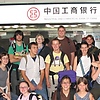
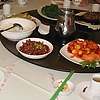
Fri, 26 Aug 2005
First full day
Following lunch we visited a hilltop park adjacent to the Forbidden City, which allows a visitor to get a sense of the full expanse of the Forbidden City in a way not possible when walking through it.
Our next and final stop was a residential area of the downtown along a lake known for its hutongs, or small alleyways. We wound our way through the area and got a glimpse of what life in Beijing was like for many people before the advent of high rise apartments and is still like for the dwindling number of Beijingers who live in this style of traditional housing.
After finding and winding our way to a small park, several students (including Dan, Jessica, Ben, Anna, and Andy pictured here) undoubtedly tired from a day of walking took advantage of the offers for a reasonably priced massage while we waited for the bus to take us back to the student center where we are staying. To top off the day, we ate a meal of famous Beijing Duck.
Tomorrows plans include a somewhat extensive and hopefully spectacular hike on a less touristed part of the Great Wall.
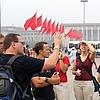
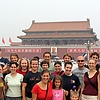
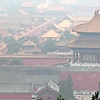
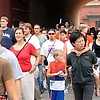
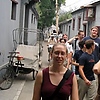
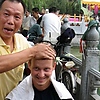
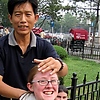
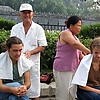
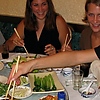
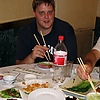
Sun, 28 Aug 2005
The Great Wall
The particular section of the wall that we visited is located about 3 hours north of Beijing. We began our hike at the Jiashanling section and proceeded to the Simatai section. While strenuous, the hike afforded stunning views of the wall and surrounding countryside as it snaked its way over the crest of the mountains, and allowed us to walk over original un-restored sections dating to the Ming dynasty.
The group picture, taken at the beginning of our hike, proves that everyone is indeed in China, a fact that some group members still have a hard time believing themselves. In another photo, Doug, Dan, Ben, and Joe enjoy their sandwich lunch on a restored section of steps. The next photo shows most of the route over which we hiked. Along the way, there were towers for resting and enjoying the view, as Sarah, Luke, Sarah, and Ben are doing. At another resting spot, Hannah, Claire, and two Chinese "guides" are slightly amused at Doug and Dans gesturing perhaps they are trying to indicate the degree of the incline? Jessica, Zeb, Megan, and Claire contemplate the final part of the trek in one of the seemingly naturally air-conditioned guard towers.
After a full day, we returned to sample more amazing Chinese cooking, and then headed for some much needed rest.
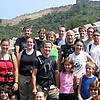
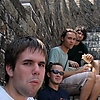

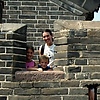
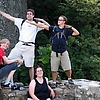
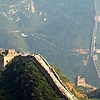
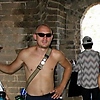
A Sunday in Beijing
Sunday morning started with the students getting their own breakfast the first meal that they had to negotiate on their own. Several students learned that not all items are ordered by the piece, but often by weight or container, which can result in a bit more food than anticipated!
After the breakfast adventures, we had the privilege of attending the Chongwenmen Christian church here in Beijing. One of the largest churches of approximately 11 Protestant churches in Beijing, we attended the middle service out of the three normally held on a Sunday. As with most services, the main sanctuary was full. In addition to the seating in the main sanctuary, services are broadcast to video monitors located in a basement area and outdoor courtyard to accommodate the normal overflow crowds. We were fortunate to have an English translation of the service.
In the courtyard of the church grounds prior to the service, Rod Suderman, our host in Beijing who has lived and worked in Beijing for eight years with the inter-Mennonite China Educational Exchange (CEE) program, gave us a brief introduction to the church and reminded us that Bibles are readily available for purchase at the church at a very reasonable price.
Following the church service, we had a noodle lunch and celebrated Stephanies birthday. The noodles could be order in differing degrees of spicyness, and Meryl and Zeb took up the challenge and ordered a 3, while a 2 was quite spicy enough for most of us.
The next stop was the Temple of Heaven park. This park is among the best examples of Ming architecture in the city. Unfortunately, the main building was closed for renovations, presumably in anticipation of the 2008 Olympics that will be held here in Beijing. Putting his accounting skills to the test, Matt tells Andy and Nathan that the platform on which they are standing is indeed built of concentric circles in multiples of 9 considered a very auspicious number by the ancient Chinese. Meanwhile, Ben and Dan try to soak up all the good luck they can by standing on the center of the circle.
In addition to the Ming architecture, the park has many wide, shaded avenues, pleasant for strolling, people-watching, or chatting with friends. Another section of the park has a long covered walkway which is a popular gathering place for the locals to play games, instruments, or gather to sing. This popularity made for some tight squeezes and a chance to literally rub elbows with the Chinese.
During the late afternoon and early evening hours the students were free to explore an interesting older part of the city and buy supper on their own. They returned excited about their experiences and full of stories about their encounters.
Monday will be our last day in Beijing. We will board the train in the evening to go to ancient city of Xian, home of the terracotta warriors.
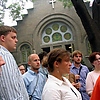
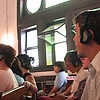
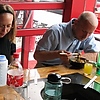
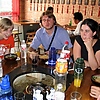
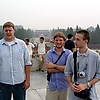
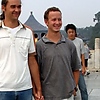
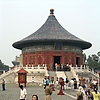
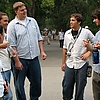
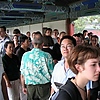
Mon, 29 Aug 2005
Final Day in Beijing
The park is quite large, and includes a large lake, which we crossed on a ferry. In addition, there is a Beijing Opera house that was used for command performances for the emperor or empress. Most impressive to many students was garden area, complete with lotus flower ponds surrounded by willow trees. Stephanie took some time to do some sketching of the area. While we waited to board the ferry, Abby, Stephanie, and Sarah take a break and try to cool off.
After visiting the Palace, we went to a local Chinese dumpling (jiaozi) restaurant, where we tasted a variety of dumpling with a wide variety of fillings. At the end of the meal, we were treated to a type of caramelized apple, made even more special because Chinese meals rarely end with a sweet dessert.
Later today we will board the overnight train to Xian, arriving in the early morning hours. The next update (including our time in Xian) will most likely be after we arrive in Chengdu on Thursday.
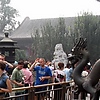
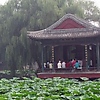
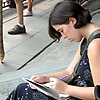
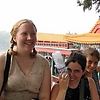
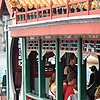
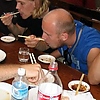
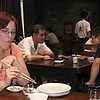
Thu, 1 Sep 2005
Xian - Day 1
Our first stop of the day in Xian was the Shaanxi Provincial History Museum. The museum houses an amazing collection of artifacts, including this example of a Tang porcelain horse being examined by Rebecca, Dan, and Sarah.
The second stop was the Big Goose Pagoda. Dating from AD 648, the grounds include a Buddhist temple and the 62 meter high pagoda, originally built to house Buddhist scriptures brought back from India, but now open for climbing, which most of the group did.
After lunch, we walked a short distance from our hotel to the Muslim quarter of Xian to visit the Great Mosque. Unique in that it is done in Chinese style, the mosque is still an active place of worship for the relatively large number of Chinese Muslims in Xian. Ben and Anna are standing in front of the Three Gates, while Matt, Joe, Andy, and Brian take a break in front of the prayer hall.
Our last stop of the day was the city wall, one of the few remaining complete city walls in China. Although the city now extends far beyond the walls borders, it gives a taste of the type of structure that would have enclosed many Chinese cities in the past. Erini, Megan, Sarah, and Jessica take in the sights from the wall, while Meryl (with Abby in back) decide to explore the wall on a tandem bicycle. Most of the males in the group took advantage of the walls vantage point to observe some nearby construction.
After a day of walking, one has to be quick with chopsticks to get a taste of favorite dishes, as the students at this table demonstrate.
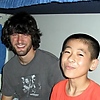
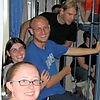
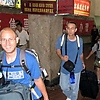
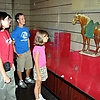
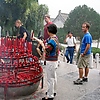
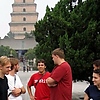
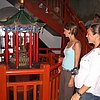
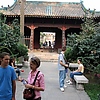
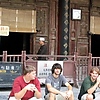
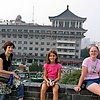
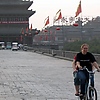
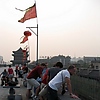
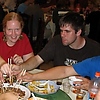
Fri, 2 Sep 2005
Xian - Day 2
One has to be present to appreciate the scale of the buried clay soldiers. The largest pit measures 230 meters long by 62 meters wide, and while not fully excavated, is believed to hold over 6,000 warriors and horses. There are 2 other pits on display, as well as acres of unexplored areas nearby that are believed to house more treasures.
Ben tried to get a picture of a few of the restored soldiers in Pit 1, while Katrina excitedly points out a feature to Megan in Pit 2. J.D., Zeb, Meryl, Jessica, Rebecca, Abby, and Anna pose inside the museum by the sign declaring the Terracotta Warriors a World Hertiage Site.
For lunch, we stopped at a local restaurant to sample some yang rou pao mo, a special type of soup. First, one breaks a dense bread (pictured in the middle of the table) into small pieces, and then the bowl is filed with a soup including pieces of mutton. It was a delicious meal and an interesting experience.
Our next venue was the Neolithic village Banpo. Unfortunately, the main excavation site was closed, so we had to settle for exploring the other areas of the museum, including several small museums. We also found a working millstone which Sarah and Luke take a turn powering. Dan, Doug, and Brian get in touch with their own Neolithic selves in another case of life imitating art.
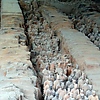
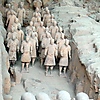
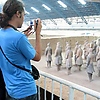
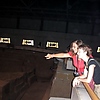
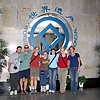
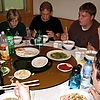
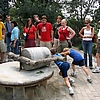
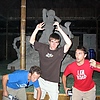
Mon, 5 Sep 2005
Arrival and First Days in Chengdu
Despite having enjoyed the spectacular sites we visited during the last week, we were happy to finally be at our home for the next 2 � months. After the students were given a short time to find their rooms, we were given a short tour of campus. Many students later remarked that they were surprised at how small the campus seemed given that there are more than 20,000 students, how they appreciated the various parks and greenery around campus, and how it is seemingly a city within a city, with banks, supermarkets, and a variety of other shops both within the campus walls and just outside the main gates.
Friday was a full day. The morning was spent registering and doing language testing, followed by our first afternoon lecture, this one on Chinese vs. U.S. culture and communication. A highlight of the afternoon was the chance to interact with the Chinese students brought along by the professor giving the lecture. They also contributed to the presentation by giving several short skits demonstrating how Chinese interactions may differ from what our students are accustomed to.
Friday evening were we invited to a special buffet meal given by the University and Waiban office. This gave everyone an opportunity to get dressed up and, after opening speeches, enjoy a variety of Sichuan cooking. The current group of SSTers had a chance to meet several old friends of the Goshen SST program who were also invited.
Saturday started as another busy day. Our first field trip in Chengdu was to Du Fus thatched cottage. Du Fu is a Tang dynasty poet whose poetry is well known throughout China. In addition, we visited a traditional embroidery factory, where all of the stitching is still done by hand, and a brocade factory which still does weaving on traditional, hand-operated looms.
Sunday was much less scheduled; a welcome change to the pace of our last week and a half in China. Most students took the opportunity to learn the public bus system in small groups accompanied by a Chinese student. In addition to learning the bus system, it was also the first day that the students were on their own for 2 meals. (During our first few days we ate all of our meals together in the waiban dining hall. For the next several days, we will eat only one meal a day together, with students finding their own meals for the other two.) They were thankful for the opportunity to interact with new Chinese friends and have help in ordering their lunches.
Our schedule from this point on will settle into a much more regular routine generally, two hours of Chinese language study in the morning, and several lectures in the afternoons each week. There is also a field trip or two scheduled each week. Keep tuned for more updates on these and other activities!
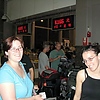
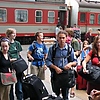
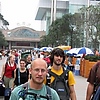
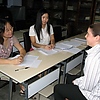
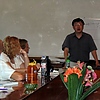
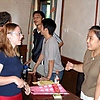
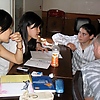
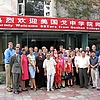
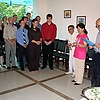
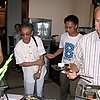
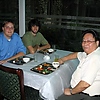
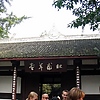
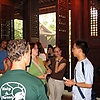
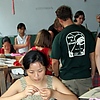
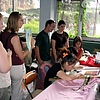
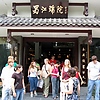
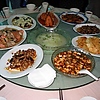
Mon, 12 Sep 2005
First Full Week
In addition to language study, there are also many other activities, such as English corner, held twice a week. English corner is a chance for the many Chinese students who are studying English to practice speaking with SSTers and other native English speakers. Students have also found that sports are another good way to interact with their Chinese peers.
Our special activities this week included a trip to the Eastern Campus of Sichuan Normal University, just a short bus ride away. This campus includes the School of Modern Arts. We were able to observe several dance classes and music lessons. The school teaches both traditional forms of dance and music, as well as modern forms. Several students have already made plans to return to observe more.
We also continued our lecture series with two more comparisons of U.S. and Chinese culture. One of these lectures was given by a very good and longtime friend of the Goshen College program in China, Frank Huang. In addition to his thoughts on China and the U.S., his provided glimpes of his personal life story which spans an extremely significant part of modern Chinese history.
Another highlight of the week, perhaps the highlight for many, was meeting host families. Each SST student is assigned to a host family so that they can experience and learn more about typical life in China. If the initial reports are any indication, this will be a very significant relationship and experience for most in the group.
Our Saturday field trip this week was to the Wuhou (Marquis Wu) Temple here in Chengdu. Actually a temple within a temple, it commemorates Zhuhe Liang and Liu Bei, famous war strategist and emperor, respectively, from the Three Kingdom Period (220-80AD) immortalized in the classic Chinese book A Tale of Three Kingdoms.
The remainder of Saturday, and Sunday were spent in a variety of activities and gearing up for another week of learning and living here in China.
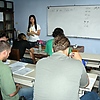
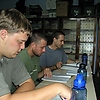
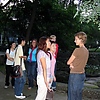
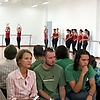
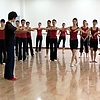
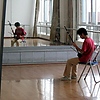
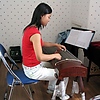
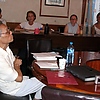
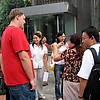
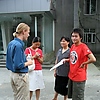
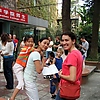
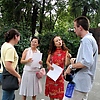
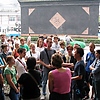
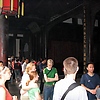
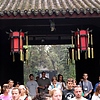
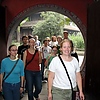
Sun, 18 Sep 2005
Second Week
Our lectures this week were on modern Chinese history, specifically the Cultural Revolution and the more recent Reform and Opening since Deng Xiaoping.
On Tuesday morning we took a field trip to the Eastern Campus of Sichuan Normal University to visit the College of Visual Arts. In addition to visiting traditional Chinese painting, lacquer painting, oil painting, video editing classes, and a student art gallery, we also were give a short lecture and demonstration on traditional Chinese landscape painting. Several students also tried their hand using traditional Chinese materials and methods.
On Thursday morning we again took a field trip, this time to the Sichuan Opera School here in Chengdu. This technical school began in 1953 and teaches children ages 5 to 14 the basics of Sichuan Opera acrobatics, vocal and instrumental music. The children board at the school for 4 to 5 years, learning both technical skills and also academic lessons. After they graduate they join opera or acrobatics troupes, or go on for further study.
The students were able to see the acrobatic and flexibility skills of the young kids up close as they practiced with their coaches. They also listened to older students practicing music on traditional Chinese instruments.
In addition to these activities, there were two other very special events. The first was that the students met the classes of Chinese students (or representatives from the classes) to whom they will teach English beginning next week. While some students were initially a bit nervous about this initial encounter, they found that they were given very warm welcomes by their students-to-be. The SST students will teach classes weekly from now until the end of our time in Chengdu, beginning with two hours each week and increasing to four about midway through the semester.
Our second special activity was a visit to the Panda Research and Breeding center just outside of Chengdu. Opened in 1986, the center has played a very important role in the research and breeding of pandas (and the less well known lesser panda). It is estimated that there are only about 1,000 pandas left in the wild, all within China, and most within the western reaches of Sichuan province. We got to see a 2 week-old panda cub, and there was even an opportunity to hold one of the lesser pandas, which several students took advantage of.
In addition to these activities, students are also beginning to spend more time with their Chinese friends and host families. A couple of students have already attended Chinese weddings, and many have spent time celebrating the traditional Mid-Autumn Festival (according to the lunar calendar) with host families this weekend. This festival consists of getting together with family or friends and looking at the full moon, while eating moon cakes, a small round dense cake with a variety of fillings.
In addition to our regular activities, this coming weeks schedule includes lectures on the role of women in China, a lecture/demonstration of Chinese calligraphy, and an all-day field trip to the 2,000 year old Dujiangyan Irrigation system.
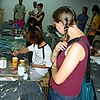
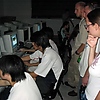
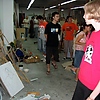
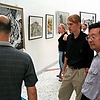
Sun, 25 Sep 2005
Week Three
Our lectures this week were Women in China given by the head of the Chengdu Womens Research Institute, and A Young Persons Perspective given by a senior college students. Both were instructive and enlightening.
A special lecture/demonstration/ practice session was on Chinese calligraphy. After being given a short introduction to the tools and techniques, students had a chance to practice. They soon found that little things matter very much, such as hold to hold the brush.
Coming up: Taijiquan practice; a lecture on Chinese economics; and Chinas own Independence Day the 56th anniversary of the founding of the Peoples Republic of China on October 1, 1949.
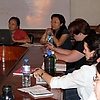
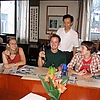
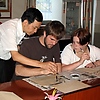
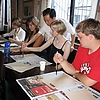
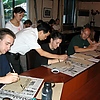
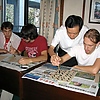
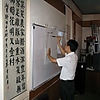
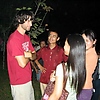
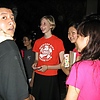
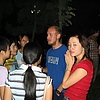
Dujiangyan and Qingcheng Shan
Built in the 3rd century B.C. in order to both help control flooding and to help irrigate the Sichuan plain basin, the Dujiangyan system has been in use ever since. Basically a device to split the river into different sections, it helped Sichuan earn its title of breadbasket of China, and currently irrigates over three million hectares of land. One of the reasons for its longevity is that the engineer, Li Bing, devised a method whereby the silt buildup was limited and could be easily removed.
Already a gray and cloudy day, the rain started almost on queue as we arrived at Qingcheng Shan. A Daoist mountain with a summit of about 1600 meters, even in the rain we could get glimpses of the beauty around us. Along the way to the top are several active Daoist temples, which gave places to explore out of the rain. Despite the less-than-ideal weather, everyone seemed to enjoy the chance to get out of the city and use their muscles.
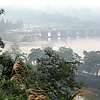
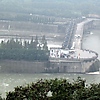
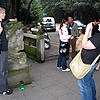
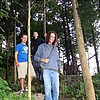
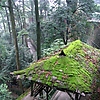
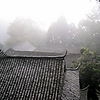
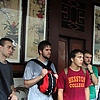
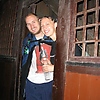
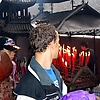
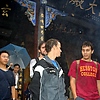
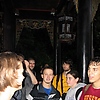
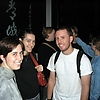
Sat, 1 Oct 2005
Economics, Taiji, and a break from routines
Given the rapid economic growth in China, students had quite a few questions about many aspects of how economics work here from how healthcare is paid for, how revenues are collected, and how growing income disparities may impact the future of China.
It was good to exercise our bodies a bit during Taiji practice. Taiji uses relatively slow motions which are fairly simple when done in small pieces, but executing them correctly as a whole routine takes quite a bit of practice and endurance. A small group of SSTers are doing four hours of Taiji tutoring a week, and report that it is simultaneously challenging and relaxing.
October 1 begins the National Day Holiday. There are no classes next week for SST or Chinese students. Most SSTers are looking forward to a break from classes and other activities, and will be traveling with host families or other Chinese friends to various locations in Chengdu or in Sichuan province. They should return with interesting stories (and hopefully a few pictures) to share with each other and perhaps with those of you following our adventures on the web.
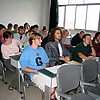
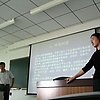
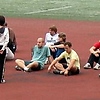
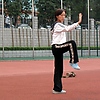
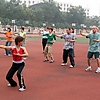
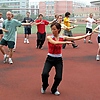
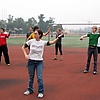
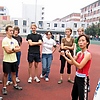
Tue, 11 Oct 2005
National Day Holiday - Flower Show
Students did a variety of things during the week, but a highlight for many were the trips they took with their Chinese friends. Some of these were day trips in or close to Chengdu, while other involved going a bit further afield.
In this entry and the two subsequent ones are just a few representative pictures from three groups of students and their activities during the National Day holiday break.
Here, Rebekah, Sarah, and J.D. and some friends attend the 6th China Flower Exposition that was in town during the holiday.
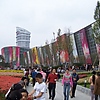
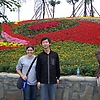
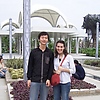
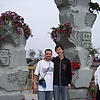
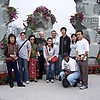
National Day Holiday - Tibetan Village
In addition to staying in a local familys home, they also had a chance to explore the village, its many stone buildings, and the rugged mountains surrounding it. They also experienced a bit of the traditions of the local people, including an evening of traditional dances around a fire complete with a roasted goat!
One the ride home, Joe and Brian rode in the back of a truck which gave them a unique perspective on their surroundings. 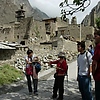
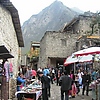
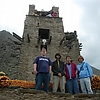
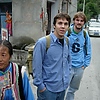
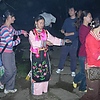
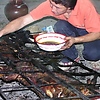
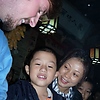
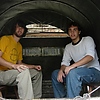
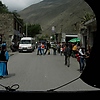
National Day Holiday - Trip to the Countryside
Ben and Dan even joined in in playing the traditional Chinese pastime, mahjong, much to the amusement of their hosts. Probably equally entertaining to those accompanying them was the time they spent at the local karaoke hall singing some golden oldies (sorry, no audio is available!).
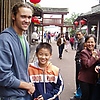
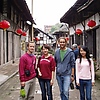
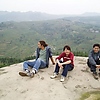
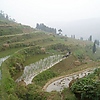
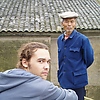
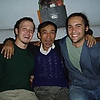
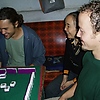
Mon, 24 Oct 2005
The Church in China and Dorm Life, Chinese Style
The visit to the church in Chengdu was hosted by Yuan Shiguo (Peter Yuan), currently General Director of the Sichuan Christian council, and a graduate of Eastern Mennonite Seminary. After attending the morning service, which included greetings and a song by the group, we then went to the seminary that is located next to the church. The seminary was founded in 1984 and serves the Protestant churches in Sichuan province and two surroundings provinces. Peter introduced us to the seminary and its work, and also helped to dispel the many misconceptions surrounding the church in China. While it faces many challenges, it is clear that the church in China is very much alive and growing.
Later in the week, students took their bedding and personal items and moved into dorms on the Eastern campus of Sichuan Normal University, a 20 minute bus ride away. The Eastern campus is home to about 30,000 students, so it feels quite different from the dorm experience of our students at Goshen. For the next two weeks, this will be home for them. Some were placed in 4-person rooms, while others were placed in the more typical 8-person rooms. Each room had private bathrooms, something not common in Goshens dorms! This short time in the dorms will give the SST students better insight into the lives of their Chinese counterparts, and is already resulting in many new friendships.
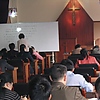
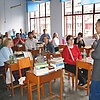
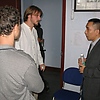
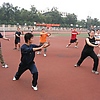
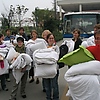
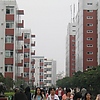
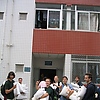
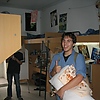
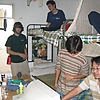
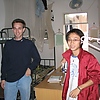
Tue, 25 Oct 2005
Sichuan Opera
This performance came just before a weekend administrative visit by Tom Meyers, Goshens Director of International Education. The same weekend, we also heard from China Educational Exchange (CEE) teachers teachers Kevin and Sara Gnida about their experiences and encounters during their 5 years of teaching in China. (CEE is an inter-Mennonite agency that sends short and long-term teachers to China. For more information, see their website at www.chinaeducationalexchange.org
)
Another activity was a visit to the Chengdu Childrens Welfare Institute. This orphanage is home to approximately 600 children and is a model facility both in terms of the physical surroundings and their approach to caring for the children. Our only regret was that our short visit precluded any significant interactions with the children there.
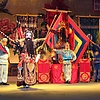
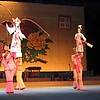
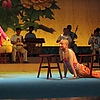
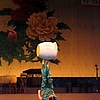
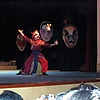
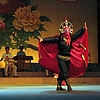
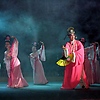
Mon, 31 Oct 2005
Leshan and Mt. Emei
Located at the confluence of three rivers, the giant Buddha was built in the belief that it would help to avoid disasters at the dangerous spot. Perhaps ironically, today the best way to see the Buddha in its entirety is via a boat ride on the river. After the boat ride, we were able to hike down to the base of the Buddha and better appreciate its size by standing next to and being dwarfed by its big toe.
After spending the night at a hotel nearby Mt. Emei, we spent Sunday hiking on the mountain. While some pressed on to see how high they could climb, others took a more leisurely pace. A highlight for many visitors to the mountain and our group was no exception is visiting the area of the mountain where the monkeys interact with the hikers. Although not tame, they readily interact with passersby, as a few in our group found out.
It seems that everyone enjoyed the chance to get out of the city and experience a bit more of nature over the weekend.
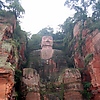
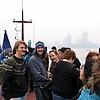
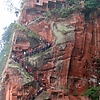
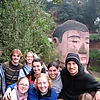
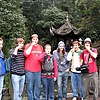
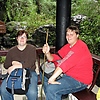
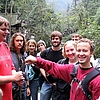
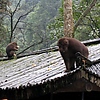
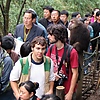
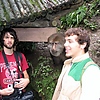
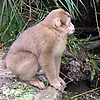
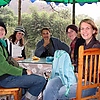
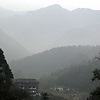
Sat, 5 Nov 2005
Return to main campus; Halloween!
Once settled into their new rooms, the students also settled back into the familiar routine here on main campus. Special activities included:
But the big event of the week was Halloween! Or more specifically, the Halloween party on Sunday evening. A joint effort of both SST and Chinese students, it included presentations and performances, games and contests, and a haunted house. Since Halloween is not celebrated in China, many of the approximately 400 Chinese students who attended were mystified by these already strange people dressing and acting even more strangely than normal. While candy and games seem to be universal, the haunted house was quite mystifying and horrifying to the Chinese. Despite the very loud and very real screams, everyone seemed to enjoy experiencing the tricks as well as the treats of Halloween.
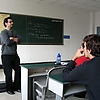
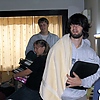

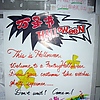
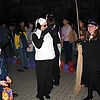
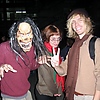
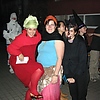
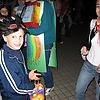

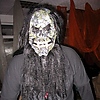
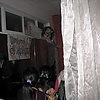
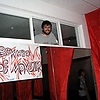
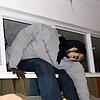
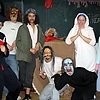
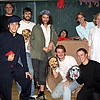
Mon, 14 Nov 2005
TV College Visit/Performance
The evening consisted of a short welcome and tour of campus, followed by a meal in the dining hall. The featured event of the evening, however, was a performance in which we were both audience members and performers. As a group, we performed two songs (hymns), while Steph and Claire read a Chinese poem in English and American sign language, and the "bucket brigade" (aka GC Drum Corps - China) did their performance, all seemingly to the delight of the audience.
The remainder of the week was somewhat quiet, with students starting to present their special projects an area of interest that they delved into in some depth, in order to learn more about China and Chinese culture in some way. As we begin our last week, students are also starting to do things for the last time and beginning the process of saying goodbye to the places and people that have been home for them for the last three months.
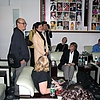
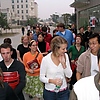
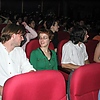
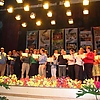
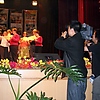
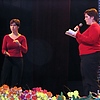
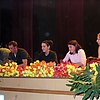
Sat, 19 Nov 2005
Final Days
The remainder of the week was filled with many lasts and goodbyes as we approach the end of our sojourn in Chengdu. We were given a farewell dinner by the foreign affairs office, and each student was presented with a certificate and a small gift as a remembrance of their time studying here at the university.
Tomorrow we will leave Chengdu for Hong Kong, where we will spend several days exploring the city and its unique status since 1997 as a Special Administrative Region (SAR) of China, after having been a British Royal Crown Colony for more than 100 years. By mid-week, China SST 2005 will be finished. But we what we have studied and experienced will continue to be a part of who we are and who we will become.
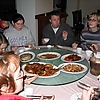
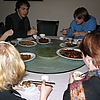
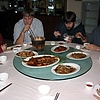
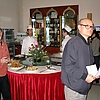
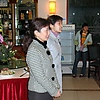
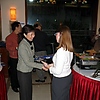
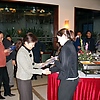
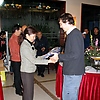
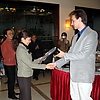
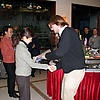
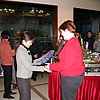
![]()
International Education Office
Kevin Koch
kevinak@goshen.edu
+1 (574) 535-7346